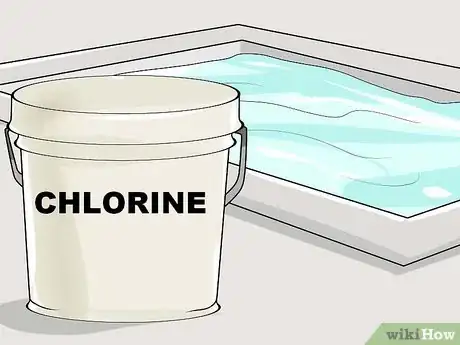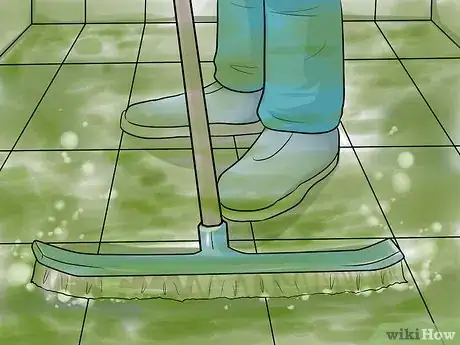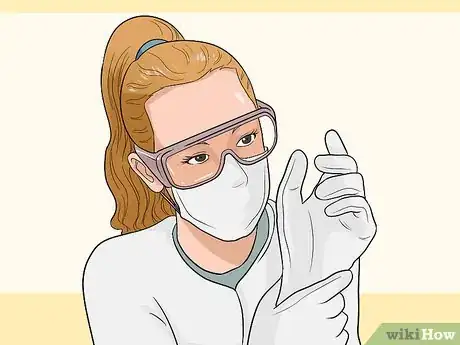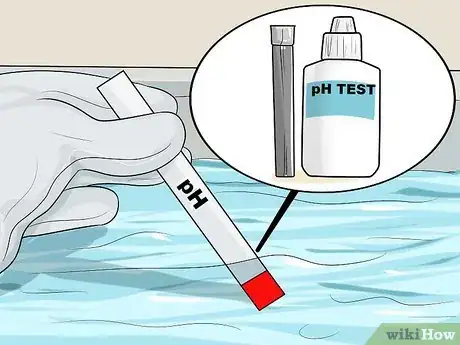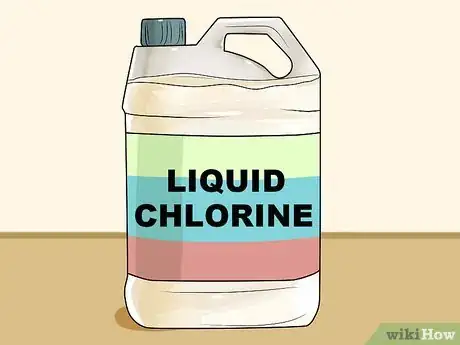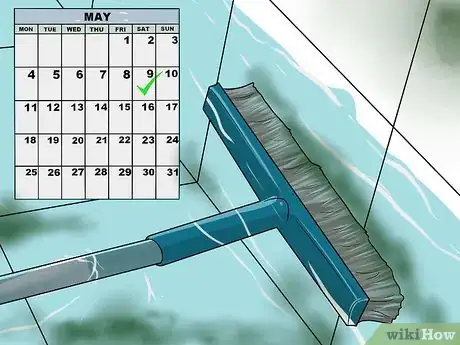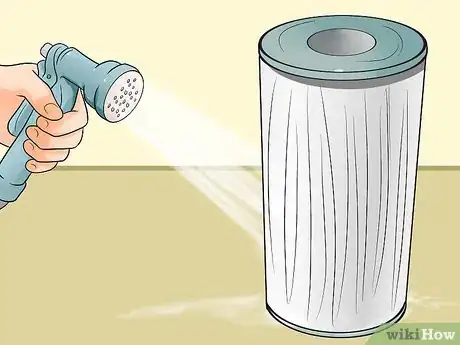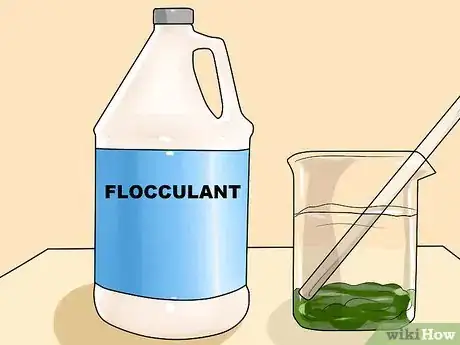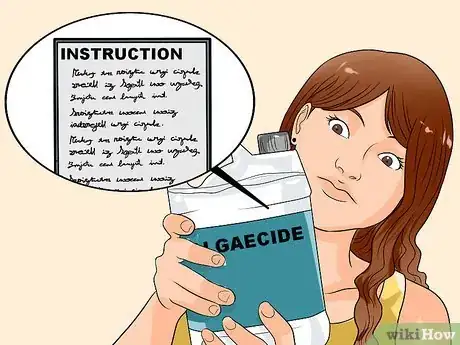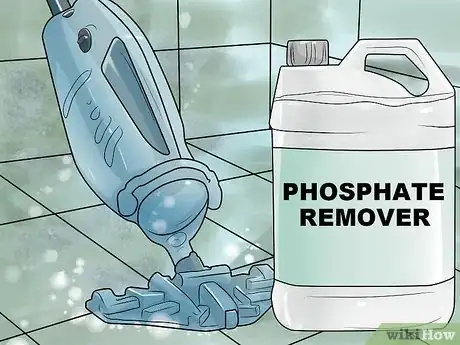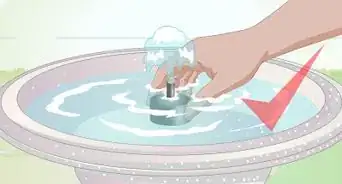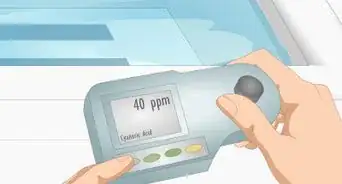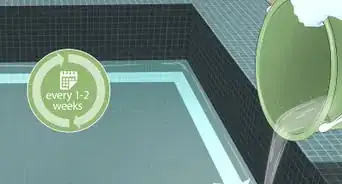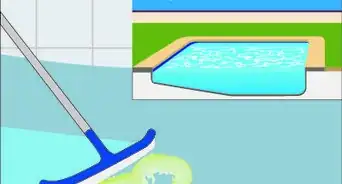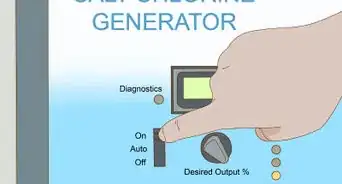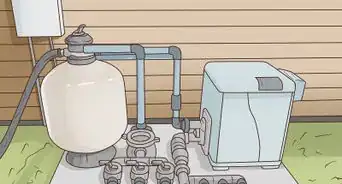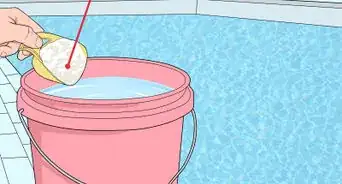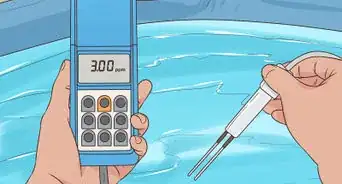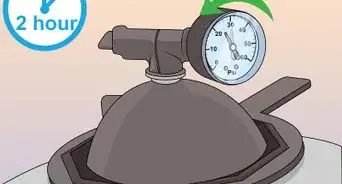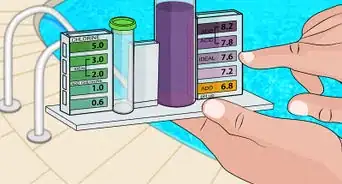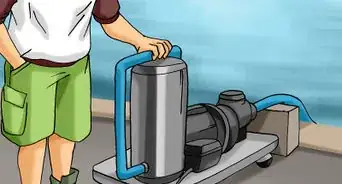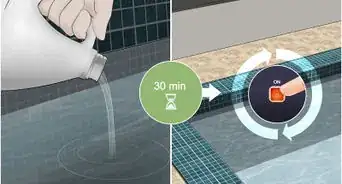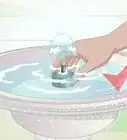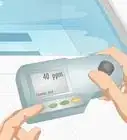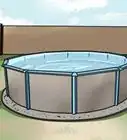wikiHow is a “wiki,” similar to Wikipedia, which means that many of our articles are co-written by multiple authors. To create this article, 33 people, some anonymous, worked to edit and improve it over time.
There are 8 references cited in this article, which can be found at the bottom of the page.
wikiHow marks an article as reader-approved once it receives enough positive feedback. This article received 23 testimonials and 92% of readers who voted found it helpful, earning it our reader-approved status.
This article has been viewed 1,513,530 times.
Learn more...
Green water or floating algae are common problems in swimming pools. Treatment can take multiple chemicals and several days of waiting if the algae has had time to build up. You can prevent the algae from returning with much less effort through regular pool maintenance.
Steps
Killing Green Algae with Chlorine
-
1Use chlorine as your go-to algae killer. When your pool water is green or contains visible algae clumps, your pool does not have enough chlorine. "Shocking" the pool with a large dose of chlorine is the most effective way to kill the existing algae and bring your pool back to sanitary conditions. This usually works within 1–3 days, but can take up to a week if pool conditions are poor.
- The other methods listed below are faster, but may not fix underlying sanitation concerns. They are also more expensive and can have unwanted side effects.
-
2Brush the walls and floor of the swimming pool. Brush vigorously to remove as much of the algae as possible. This will reduce the amount of time it takes to kill and clear the algae bloom. Pay special attention to the steps, behind ladders, and other nooks and crannies where algae tends to gather.
- Make sure the brush is compatible with your pool. Steel brushes work well on concrete, while nylon brushes are preferable for vinyl pools.[1]
Advertisement -
3Review pool chemical safety. You'll be handling dangerous chemicals during this method. Always read the safety information on the labels first. At minimum, follow these safety standards for all pool chemicals:[2]
- Wear gloves, eye protection, and clothing that covers your skin. After use, wash hands and inspect clothes for chemicals.
- Avoid inhaling the chemicals. Use caution when handling in windy weather.
- Always add chemicals to water, never water to chemicals. Do not place wet scoops back in container.
- Store chemicals in sealed, fireproof containers, away from children, on separate shelves on the same level (not one above the other). Many pool chemicals explode when they touch another pool chemical.
-
4Adjust the pool pH. Use a swimming pool pH test kit to measure the pH of your water. If the pH is above 7.6 — which is common during an algae bloom — add a pH reducer (such as sodium bisulfate) to your pool according to label instructions. Aim for pH levels between 7.2 and 7.6 to make your chlorine more effective and reduce the growth of the infestation.[3] Wait at least a couple hours, then test the pool again.
- Test kits that use tablets or droppers are much more accurate than paper test strips.[4]
- If pH levels are back to normal but total alkalinity is above 120 ppm, check the pH reducer label for instructions to bring total alkalinity down between 80 and 120 ppm.
-
5Choose a chlorine shock product. The chlorine you use for regular pool treatment may not be the best choice for a shock treatment. Ideally, you should use a liquid chlorine product intended for swimming pools. The product should contain sodium hypochlorite, calcium hypochlorite, or lithium hypochlorite.[5]
- Avoid calcium hypochlorite if you have hard water.
- All hypochlorite products are flammable and explosive. Lithium is relatively safer, but much more expensive.
- Avoid granular or tablet chlorine products (such as dichlor or trichlor), which contain stabilizers that should not be added to the pool in large quantities.
-
6Add an extra large dose of shock. Check your chlorine product's label for "shock" instructions. To fight algae, use twice the recommended amount for a regular shock. Use triple the amount if the water is very murky, or even quadruple if you can't even see the top rung of the ladder.[6] With the pool filter running, add the shock directly to the perimeter of the pool. (If you have a vinyl pool liner, pour the shock into a bucket of pool water first to avoid bleaching.)
- Warning — liquid chlorine will explode and produce corrosive gas if it touches chlorine tablets or granules. Never pour the liquid chlorine into your pool skimmer or anything that contains these products.
- Because UV rays in sunlight break down chlorine, shocking is most effective when added in the evening and left overnight.
-
7Test the pool again the next day. After the pool filter has been running for 12–24 hours, examine the pool. Dead algae turns white or gray, and either suspends in the pool water or settles to the floor. Whether or not the algae is dead, test the pool again for the new chlorine and pH levels.
- If your chlorine levels are higher (2–5 ppm) but the algae is still there, keep maintaining these levels as usual for the next couple days.
- If chlorine levels have risen but are still below 2ppm, shock a second time the next evening.
- If there was no significant change in your chlorine levels, your pool likely has too much cyanuric acid (more than 50 ppm). This comes from using granulated or tablet chlorine, and can "lock" your chlorine into unusable forms. The only way to fight this is to shock repeatedly (sometimes many times), or to partially drain your pool.
- Large amounts of leaf litter or other objects in the pool can also eat up your chlorine. If the pool has been unused a long time, this could take a full week and several shock treatments.
-
8Brush and test daily. Brush vigorously to fight new algal growth on the walls. Over the next couple days, the chlorine should kill the algae. Test daily to confirm that chlorine and pH levels are acceptable.
- A well maintained pool has roughly the following values: Free Chlorine: 2-4 ppm, pH: 7.2 – 7.6, Alkalinity: 80 – 120 ppm and Calcium Hardness: 200 – 400 ppm.[7] Slight differences in standards are common, so a small deviation should not be an issue.
-
9Vacuum the dead algae. Once there is no green color left in your pool, vacuum up all the dead algae until the water is clear. You may skip this step and let the filter handle it, but only if you have a powerful filter and are willing to wait several days.
- If you're having trouble getting all the algae, add coagulant or flocculant so it clumps together. These are available at pool stores, but may not be worth the purchase for a home pool.
-
10Clean the filter. If you have a D.E. filter, set it to backwash. If you have a cartridge filter, remove it and clean the cartridge with a hose at high pressure, followed by dilute muriatic acid or liquid chlorine if necessary. If you do not clean the filter thoroughly, dead algae may block the filter.
Other Green Algae Treatments
-
1Improve circulation to handle small spots of algae. If small clumps of algae form but do not spread to the rest of the pool, you may have areas of stagnant water. Check that your water jets are functioning properly. They should point into the water at an angle, so the water moves in a spiral pattern.[8]
-
2Gather the algae with a flocculant. A flocculant or coagulant clumps the algae together, making it possible to vacuum living algae. This may take a hard day of work, but your pool should be clear by the end of it.[9] This is the fastest way to get your pool looking good, but it does not make the water safe to swim in. If algae can multiply, so can viruses and bacteria. Follow this with a chlorine shock treatment to sanitize the pool, and do not swim in the pool until chlorine and pH levels are back to normal.
-
3Treat the pool with algaecide. Algaecide will certainly kill your algae, but the side effects and expense may not be worth it. Here are a few factors to weigh when considering this option:[10] [11]
- Some algaecide products are not powerful enough to treat an existing bloom, especially if you have black algae as well. Ask a pool store employee for help, or find a product with 30%+ active ingredients.
- Quaternary ammonia algaecides ("poly quats") are cheap, but cause your water to foam. Many people find this annoying.
- Copper-based algaecides are more effective, but expensive. They usually stain your pool walls as well.
- After adding the algaecide, wait at least 24 hours before adding other chemicals.
Preventing Algae
-
1Maintain your pool water. Algae should not grow if you keep on top of your pool chemistry. Test the pool regularly for free chlorine levels, pH, alkalines, and cyanuric acid. The faster you catch a problem, the easier it will be to deal with it.
- Daily testing is ideal, especially in the week or two following an algal bloom. Always test at least twice a week during the swimming season.
-
2Add an algaecide as a preventative. Algaecides are best used in small, weekly doses when pool conditions are normal. This will kill algae populations before they have a chance to grow. Check the product label for instructions.
- Make sure to follow instructions for regular prevention, not for existing algae blooms. Too much algaecide may stain your pool or cause foaming.
-
3Remove phosphates. Algae feed off several nutrients in the water, notably phosphates. Phosphate test kits are a cheap way to test for these chemicals in your pool. If they are present, use a commercial strength phosphate remover from a pool supply store. Let the filter and robot or manual vacuum remove the phosphate remover over the next day or two. Shock the pool once the phosphates are at a reasonable level.
- Pool professionals disagree over acceptable phosphate levels. 300 ppm is probably low enough unless you have recurring algae problems.[12]
Community Q&A
-
QuestionHow do I prevent DE powder from entering the pool?
 Community AnswerIf DE powder is entering the pool, one or more of your septum elements is torn or not properly connected to the header.
Community AnswerIf DE powder is entering the pool, one or more of your septum elements is torn or not properly connected to the header. -
QuestionCan I empty an above ground pool without it caving in?
 Community AnswerYes, it will not cave in if the top bars are all in place. But do what you have to do and refill as quickly as possible. Letting the vinyl liner dry out in the sun can allow it to shrink. Fill the pool on an 80 degree, sunny day ONLY. Don't fill at night.
Community AnswerYes, it will not cave in if the top bars are all in place. But do what you have to do and refill as quickly as possible. Letting the vinyl liner dry out in the sun can allow it to shrink. Fill the pool on an 80 degree, sunny day ONLY. Don't fill at night. -
QuestionHow do I get algae out of my pool without vacuuming?
 Community AnswerYou can brush it, causing it to stir up into water, and then let the filter grab it. However, if you do that, you're going to have to backwash it a few times throughout the process.
Community AnswerYou can brush it, causing it to stir up into water, and then let the filter grab it. However, if you do that, you're going to have to backwash it a few times throughout the process.
Warnings
- The swimming pool cannot be used until the algae is dead, and the chlorine level of the pool water has returned to a safe level of 4 ppm or less.⧼thumbs_response⧽
References
- ↑ http://pooluniversity.org/green-algae-pool-get-rid-algae-pool/
- ↑ http://www.achd.net/housing/PoolSafety.html
- ↑ https://blog.intheswim.com/pool-ph-and-alkalinity-problems/
- ↑ https://www.youtube.com/watch?t=58&v=zkAXuHaiX4A
- ↑ http://blog.intheswim.com/the-ultimate-guide-to-pool-chlorine/
- ↑ http://pooluniversity.org/green-algae-pool-get-rid-algae-pool/
- ↑ http://chlorine.americanchemistry.com/Pool-Treatment-101
- ↑ https://www.youtube.com/watch?t=58&v=zkAXuHaiX4A
- ↑ http://www.swimuniversity.com/how-to-get-rid-of-swimming-pool-algae/
About This Article
To eliminate and prevent green algae in a swimming pool, start by adding an extra dose of chlorine to your pool to shock the algae and stop the bloom. Let the chlorine work overnight, then test the pH levels of the pool in the morning to see if the pH is back to normal. Next, use a pool brush to scrub algae off the walls of the pool, then vacuum up any dead algae. To prevent it from blooming again, test your pool’s chemical levels daily and make adjustments as needed. For more ways to prevent algae in your swimming pool, read on!
